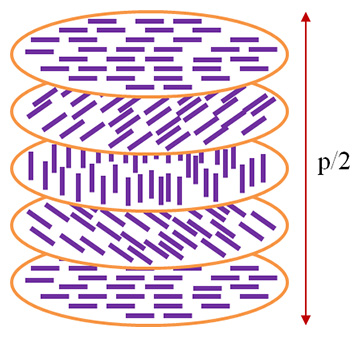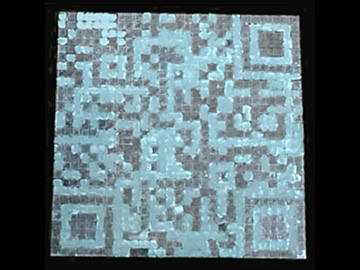![]()
A team at Nagoya University, Japan, has developed a method for creating micrometer-scale spheres with a chiral structures. The spheres produce polarization-sensitive structural colors that vary depending on particle size. [Image: Yukikazu Takeoka and Jialei He]
Researchers in Japan have devised a new approach for creating micrometer-scale spherical liquid-crystal particles with a gift for producing highly controllable structural colors (Adv. Opt. Mater., doi: 10.1002/adom.202300296). Further, by combining the microspheres with commercial pigments, the team was able to fashion an extra-secure “chiral” QR code displayable only under circularly polarized light. The researchers think their approach could “enrich the application of structural color in the field of chiral optical anti-counterfeiting.”
Digging into CLCs
Structural coloration is a feature found in the animal kingdom, in creatures ranging from insects such as the blue morpho butterfly to birds such as the peacock. In this mode of color creation, nanostructures in scales, feathers and other features cause light to scatter and interfere, resulting in brilliant, iridescent and shifting hues. Researchers have expended considerable effort in recent years toward bio-inspired, human-created structural colors as a possible replacement for environmentally harmful conventional pigments and as a potential anti-counterfeiting tool.
One intriguing platform for human-made structural color is so-called cholesteric liquid crystals (CLCs), sometimes referred to as chiral nematic liquid crystals. These are layered structures in which the crystal orientation repeats in a twisting, helical pattern. Thus the crystals embed a natural chirality, or “handedness,” depending on whether the helical twist is left- or right-handed.

Cholesteric liquid crystals (CLCs) have a helical structure and an in-built chirality, or “handedness,” depending on the direction of the helical twist. The helical pitch, p, measures the vertical distance over which one full helical rotation occurs. [Image: LuisErickCoy/Wikimedia Commons, CC-BY SA 3.0]
Among other things, the CLCs’ helicity causes their dielectric constant and refractive index to vary periodically. CLCs can thus produce structural colors, which change depending on the viewer’s orientation relative to the helix. And it turns out that the wavelength of the structural color depends primarily on the vertical distance between loops in the crystal’s helical structure, a parameter called the helical pitch. Changing the helical pitch changes the photonic band gap of the Bragg reflection. As a result, CLCs with a shorter helical pitch will produce colors toward the blue end of the spectrum; a longer helical pitch pushes things closer to the red end.
Size matters
To better use CLCs for creating structural color, researchers have sought efficient ways to create tiny spherical particles of the material. This carries a double benefit. Spherical CLCs help eliminate the directionality problem, making the structural coloration independent of the viewing angle. They also open up interesting possibilities for anti-counterfeiting technology. That’s because of their chirality—which, the authors of the new study write, allows spherical CLC particles to produce “unique, circularly polarized structural colors that are easy to read and difficult to replicate.”
But there’s been a hitch: It’s been tough to make these CLC microspheres small enough to be useful in many structural-color applications. Spheres made by common techniques tend to be on the order of 10s of µm to 100 µm in diameter. But for optimal use in coloration and anti-counterfeiting schemes, the particle sizes need to be 5 µm or less.
Learning from Gloriosa

The scarab beetle Chrysina gloriosa shows polarization-dependent structural colors tied to micrometer-scale CLCs in its exoskeleton. [Image: Gypsy Picture Show/Getty Images]
The research team behind the new work, led by Jialei He and Yukikazu Takeoka at Nagoya University, sought to get past this hurdle by finding a way to create micrometer-scale CLCs. In the quest, they were inspired by a natural example: the Gloriosa beetle. That critter creates vivid, naturally induced structural colors via uniform, micrometer-scale CLC particles embedded in its exoskeleton. And, because of the particle chirality, the color and quality of the reflection off of the beetle’s shell differ dramatically depending on the polarization of the incident light.
To follow the beetle’s example, the Nagoya team adapted a previously developed method for creating spherical liquid crystals, known as dispersion polymerization. By tweaking the dopant chemistry and other aspects, the researchers were able to synthesize CLC spheres on the order of 1 µm in diameter that displayed bright, chiral, angle-independent structural color—something, the authors maintain, that has been “unattainable by other 3D photonic crystals or microfluidic techniques.” What’s more, the team found that coating the spheres with a layer of polydimethylsiloxane (PDMS) greatly increased their stability at increased temperatures and improved the look of the structural color.
Chiral QR codes from CLC microspheres
In the course of their experiments, the researchers stumbled on another, unexpected benefit: the structural color produced by the CLC microspheres depends on their size. Apparently, this is because changing the diameter of the microspheres created using the group’s approach results in similar changes to the helical pitch of the CLCs. That means that the resulting structural color can be varied simply by adjusting the particle size, without altering the chemistry or dopants used.

The team used its chiral CLC structural-color microspheres, along with a similarly colored, non-chiral conventional pigment, to create QR codes visible only under left-circular-polarized light. [Image: Yukikazu Takeoka and Jialei He]
To put their approach to a practical test, the researchers bought acrylic sheets that had been laser engraved with 2D, 29×29-element patterns of square pixels. Following a specific QR code template, they filled the “white” areas of the code with their chiral structural-color CLCs, and the remaining areas with a water-based, non-chiral, non-structural-color pigment that mimicked the color produced by the CLCs. The team found that, under normal and right-circular-polarized light, the QR code was invisible, showing only as a uniform, light-blue area. Under left-circular-polarized light, in contrast, the QR code popped into view and could be decoded by an ordinary smartphone.
The Nagoya researchers believe that their method for creating structural-color CLC microspheres—a method the team describes as “simple and economical”—could open some new possibilities for putting structural color to work. “As well as being used [as] a special functional pigment for anti-counterfeiting,” co-lead researcher Takeoka said in a press release accompanying the work, “it can also be used for other applications that take advantage of the circularly polarized structural color with little angle dependence.”
